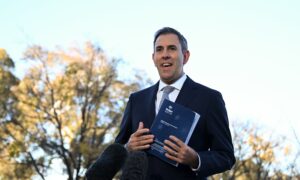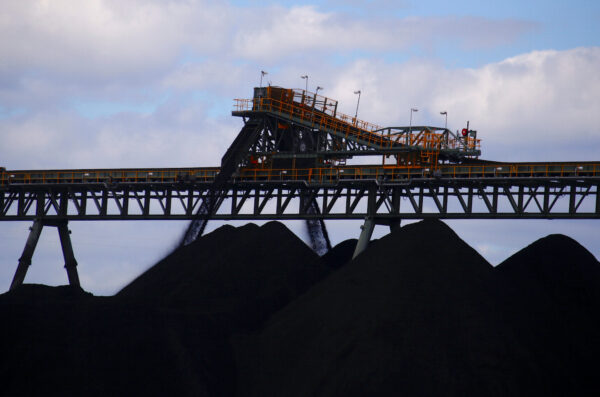Australian Government Forecasted to Deliver Brief $4 Billion Budget Surplus
Treasurer Jim Chalmers will announce a small budget surplus on Tuesday evening, the first in 15 years primarily driven by record-high iron ore, coal, and gas prices. The $4 billion (US$2.7 billion) surplus for the 2022-23 financial year is expected to be short-lived, and the budget will soon dip back into deficit as commodity prices return to normal and welfare payment and defence costs soar. But it is still an improvement from the $36.9 billion deficit in 2022-23 that was forecasted in the October Budget. Chalmers said it was the result of Labor’s responsible economic management through spending restraint and modest tax changes. However, he maintains a cautious approach, saying there would be no celebrations until the forecast is confirmed in September’s final budget outcome. “What’s absolutely clear is that this outcome would never have been possible without our decision to return most of the upward revisions to revenue to the bottom line,” he said. “Despite the substantial progress we’ve made, it will take more than one budget or one term to clean up the mess we inherited. “We are putting the budget on a much more sustainable footing at the same time as we provide cost of living relief and invest in the future.” However, Shadow Treasurer Angus Taylor said Chalmers should focus on maintaining the budget surplus, urging Labor to address inflation. “The only way this government can do that is by putting the interests of Australians first and resisting traditional Labor principles of higher taxes and higher spending,” he said. “The challenge of inflation is that spending more just makes it worse. Fighting inflation with handouts is like putting a band-aid on a bullet wound. The government must address the source of inflation, not the symptoms. “If Labor does not get spending under control, the Budget will drive more inflation. Unless the government limits spending, Labor will add to the cost of your mortgage, your rent, your groceries and just about everything else Australians are spending their hard-earned money on.” Considering the record amount of revenue brought in from commodities, Taylor said that a “drover’s dog” could deliver a surplus. “From when the economy opened up in late-2021 through to the May election, we were in surplus,” he told Sky News Australia on Sunday. “So there’s no excuse here. Labor should be delivering surpluses, but they should be maintaining it—and that’s the real test of the budget.” Coal is unloaded onto large piles at the Ulan Coal mines near the central New South Wales rural town of Mudgee in Australia on March 8, 2018. (David Gray/Reuters) Cost of Living Relief the Centrepiece of May Budget Tuesday’s budget will include a $14.6 billion (US$10 billion) cost of living relief package, which Chalmers insists will not worsen inflation. “What we’ve done is we’ve carefully calibrated and designed this budget so that it takes the pressure off the cost of living rather than add to it, and people will see how we’ve gone about that tomorrow,” he told ABC Radio. “We’re conscious as we work through the various options of which ones do and don’t add to the inflation forecasts in the budget.” Part of the relief package is a one-off energy bill support payment of up to $500, which is expected to help around 5.5 million households and one million businesses. The treasurer said the energy price relief was the best example of responsible spending as it reduced pressure on the inflation forecasts in the budget by getting some of the energy bills lower than they would otherwise be. Around $1.9 billion will also go into expanding support payments for single parents, allowing them to receive a higher level of welfare payments until their youngest child turns 14, up from the current cut-off of 8-years-old. “What that will do is to make sure that women, in particular, but also fathers in situations of raising children by themselves, can have that sense of security, that children can be looked after,” Prime Minister Anthony Albanese told reporters in Perth. “They’re deserving of more support.” Chalmers said he was very proud of the budget that he would deliver tonight but acknowledged that there were still challenges in the economy and the community. “A stronger budget position is not an end in itself. It’s the foundation on which we build everything that we want to do for our people, their economy, and our society,” he said. Alfred Bui contributed to this report.

Treasurer Jim Chalmers will announce a small budget surplus on Tuesday evening, the first in 15 years primarily driven by record-high iron ore, coal, and gas prices.
The $4 billion (US$2.7 billion) surplus for the 2022-23 financial year is expected to be short-lived, and the budget will soon dip back into deficit as commodity prices return to normal and welfare payment and defence costs soar.
But it is still an improvement from the $36.9 billion deficit in 2022-23 that was forecasted in the October Budget.
Chalmers said it was the result of Labor’s responsible economic management through spending restraint and modest tax changes.
However, he maintains a cautious approach, saying there would be no celebrations until the forecast is confirmed in September’s final budget outcome.
“What’s absolutely clear is that this outcome would never have been possible without our decision to return most of the upward revisions to revenue to the bottom line,” he said.
“Despite the substantial progress we’ve made, it will take more than one budget or one term to clean up the mess we inherited.
“We are putting the budget on a much more sustainable footing at the same time as we provide cost of living relief and invest in the future.”
However, Shadow Treasurer Angus Taylor said Chalmers should focus on maintaining the budget surplus, urging Labor to address inflation.
“The only way this government can do that is by putting the interests of Australians first and resisting traditional Labor principles of higher taxes and higher spending,” he said.
“The challenge of inflation is that spending more just makes it worse. Fighting inflation with handouts is like putting a band-aid on a bullet wound. The government must address the source of inflation, not the symptoms.
“If Labor does not get spending under control, the Budget will drive more inflation. Unless the government limits spending, Labor will add to the cost of your mortgage, your rent, your groceries and just about everything else Australians are spending their hard-earned money on.”
Considering the record amount of revenue brought in from commodities, Taylor said that a “drover’s dog” could deliver a surplus.
“From when the economy opened up in late-2021 through to the May election, we were in surplus,” he told Sky News Australia on Sunday. “So there’s no excuse here. Labor should be delivering surpluses, but they should be maintaining it—and that’s the real test of the budget.”

Cost of Living Relief the Centrepiece of May Budget
Tuesday’s budget will include a $14.6 billion (US$10 billion) cost of living relief package, which Chalmers insists will not worsen inflation.
“What we’ve done is we’ve carefully calibrated and designed this budget so that it takes the pressure off the cost of living rather than add to it, and people will see how we’ve gone about that tomorrow,” he told ABC Radio.
“We’re conscious as we work through the various options of which ones do and don’t add to the inflation forecasts in the budget.”
Part of the relief package is a one-off energy bill support payment of up to $500, which is expected to help around 5.5 million households and one million businesses.
The treasurer said the energy price relief was the best example of responsible spending as it reduced pressure on the inflation forecasts in the budget by getting some of the energy bills lower than they would otherwise be.
Around $1.9 billion will also go into expanding support payments for single parents, allowing them to receive a higher level of welfare payments until their youngest child turns 14, up from the current cut-off of 8-years-old.
“What that will do is to make sure that women, in particular, but also fathers in situations of raising children by themselves, can have that sense of security, that children can be looked after,” Prime Minister Anthony Albanese told reporters in Perth.
“They’re deserving of more support.”
Chalmers said he was very proud of the budget that he would deliver tonight but acknowledged that there were still challenges in the economy and the community.
“A stronger budget position is not an end in itself. It’s the foundation on which we build everything that we want to do for our people, their economy, and our society,” he said.












